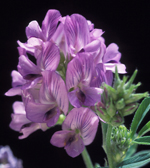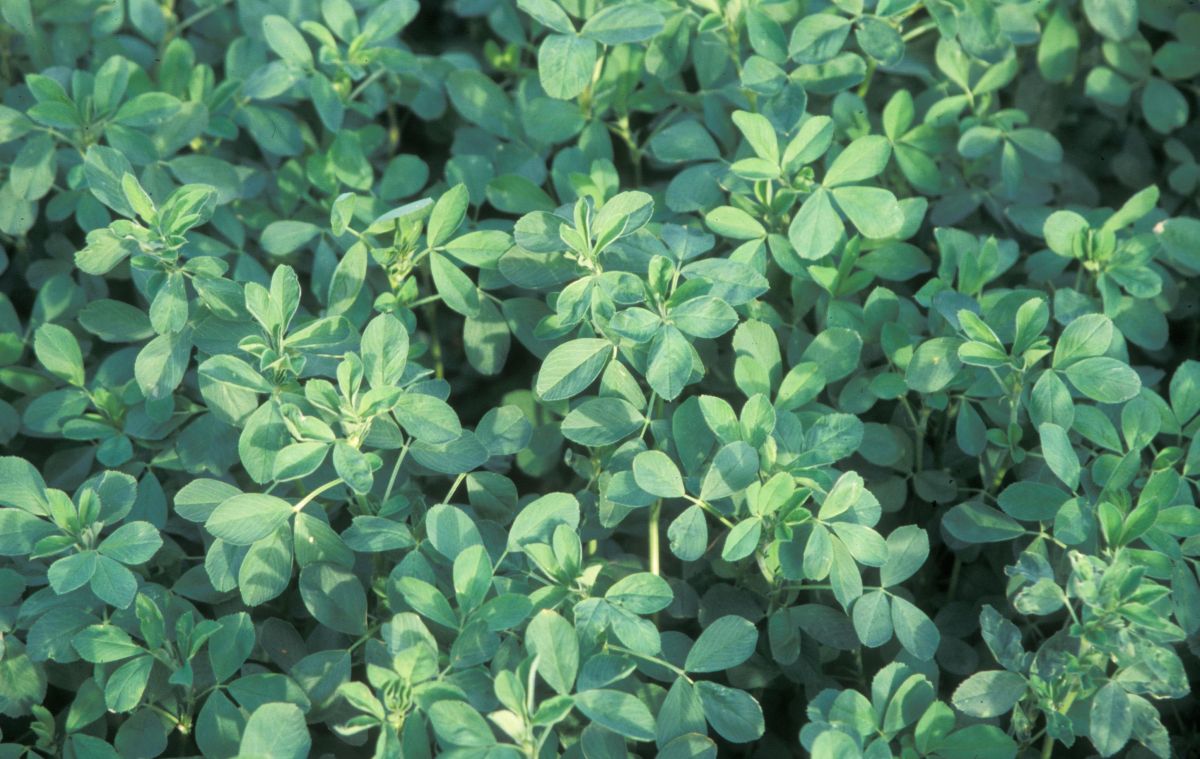Alfalfa
Alfalfa (Medicago sativa) has the highest yield potential and highest feeding values of all adapted perennial forage legumes. It is a versatile crop that may be used for pasture, hay, silage, green-chop, pellets, cubes, soil improvement, and soil conservation.
Marketing
 Alfalfa is the most important forage legume grown in the U.S., with more than 250,000 acres grown in Kentucky each year. Nearly all the hay grown in-state supports the beef, dairy, and horse industries in Kentucky and surrounding states. In addition, an increasing amount of alfalfa is being used by the sheep and goat sectors. Alfalfa has potential for the cash hay market and for intensive grazing. A diversified marketing plan is advisable, especially for growers producing alfalfa primarily for the premium cash hay market. Some cuttings may prove to be unacceptable for premium markets; those lots will have to be marketed through other outlets or used on-farm. High quality alfalfa hay can be extremely profitable for producers willing to put in extra management time and capital.
Alfalfa is the most important forage legume grown in the U.S., with more than 250,000 acres grown in Kentucky each year. Nearly all the hay grown in-state supports the beef, dairy, and horse industries in Kentucky and surrounding states. In addition, an increasing amount of alfalfa is being used by the sheep and goat sectors. Alfalfa has potential for the cash hay market and for intensive grazing. A diversified marketing plan is advisable, especially for growers producing alfalfa primarily for the premium cash hay market. Some cuttings may prove to be unacceptable for premium markets; those lots will have to be marketed through other outlets or used on-farm. High quality alfalfa hay can be extremely profitable for producers willing to put in extra management time and capital.
Production
 Choosing the proper cultivar is a critical step to establishing a good stand of alfalfa. Cultivars vary in terms of quality, yield potential, winter hardiness, stand longevity, and pest and disease resistance. Select adapted cultivars with a history of producing high yields over a number of years and in a range of locations throughout the state. Refer to University of Kentucky alfalfa variety trial results for more information on cultivar performance. Multiple cultivars can be used in large acreages. Establishing a good stand of alfalfa, whether for hay or for grazing, is expensive and time-consuming. However, the success rate is high if special attention is given to important management factors. A good, properly managed stand of alfalfa should last five years or longer.
Choosing the proper cultivar is a critical step to establishing a good stand of alfalfa. Cultivars vary in terms of quality, yield potential, winter hardiness, stand longevity, and pest and disease resistance. Select adapted cultivars with a history of producing high yields over a number of years and in a range of locations throughout the state. Refer to University of Kentucky alfalfa variety trial results for more information on cultivar performance. Multiple cultivars can be used in large acreages. Establishing a good stand of alfalfa, whether for hay or for grazing, is expensive and time-consuming. However, the success rate is high if special attention is given to important management factors. A good, properly managed stand of alfalfa should last five years or longer.

